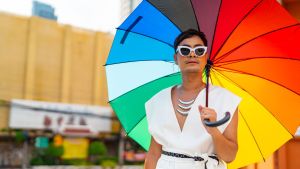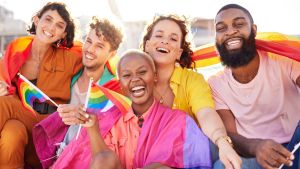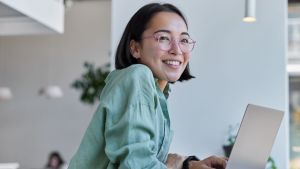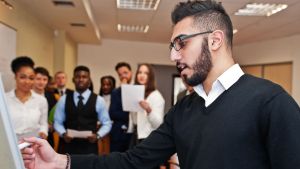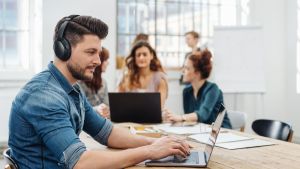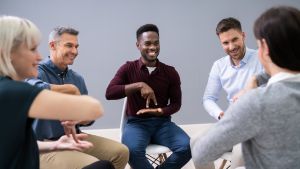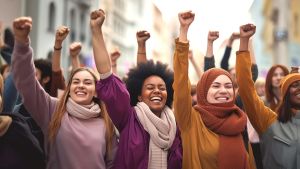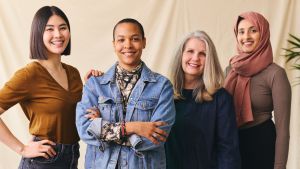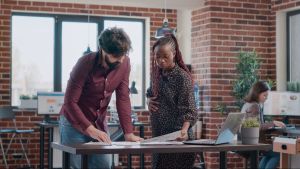Emily Ladau first ventured into disability advocacy at age 10. She appeared on several episodes of Sesame Street, where she educated children about living with a disability. Ladau was born with Larsen syndrome, a rare genetic disorder that affects the development of joints and bones throughout the body.
“My story is a little bit unique in the sense that my mother has the same physical disability as I do,” she says. “She has always been a role model, ally and supporter as has my father, although he does not share the same disability.”
Ladau is the author of Demystifying Disability: What to Know, What to Say, and How to be an Ally. She stresses that allyship doesn’t have to come from someone with a disability or marginalized identity.
“My parents were my earliest allies,” Ladau says. “But as I grew up, there were people in my life who I was lucky to connect with, who showed me that I could thrive and that my disability wasn’t something that I needed to be ashamed of.”
What Is a Disability Ally?
Sixty-one million Americans or 26% of people in the United States have some type of disability, according to The Centers for Disease Control and Prevention (CDC). Worldwide, this adds up to one billion or 15% of the global population.
“It’s one of the only identities that anyone can take on at any time and it cuts across all other identities,” Ladau says. “We tend to treat disability as though it should be relegated to the sidelines. It’s on the margins of marginalization, I often say.”
Someone who is a disability ally uses their privilege to advocate and support the disabled community.
“Allyship is not about giving yourself the title of being an ally,” says Ladau. “Some people hope that there is an allyship checklist and that it’s a linear process. If you complete the checklist, then you get a gold star that says number one ally. It doesn’t quite work like that.”
Being a disability ally is about being a good listener and observer, learning how disability affects people differently, understanding the barriers disabled people face, then taking action, while always keeping accessibility in mind.
“Allyship is a verb,” Ladau says. “It’s imperative to recognize each day you’re going to learn something new if you’re truly being an ally. It’s about conversation and open dialogue. It’s about being willing to learn. It’s about being willing to accept feedback and recognizing that you might make a mistake. That’s okay as long as you continue on your learning process.”
Learn About the Different Types of Disabilities
The first step to being an effective disability ally is to be educated about the different types of disabilities.
“When we talk about disability, you immediately picture somebody in a wheelchair who needs assistance and has a physical disability that may or may not be temporary,” says Graciano Petersen, Senior Director for Training, Culture, and Leadership Development at RespectAbility, an organization that advances opportunities for people with disabilities. “We don’t recognize that disabilities have a huge spectrum.”
The spectrum can range from visible to invisible disabilities like mental, cognitive, physical, vision or hearing impairments that may be temporary or permanent.
“You might be able-bodied one day, but the next day something could happen that makes you lose your hearing or your sight or you may have mental health issues due to the pandemic,” says Ryan Parry, a disability advocate and customer service representative with Peacock TV at Comcast NBCUniversal. “Realizing that this could happen to me as well often opens up people’s eyes in terms of closed-mindedness regarding people with invisible disabilities, whether they be neurodivergent or something different.”
Acknowledge Lived Experiences
One of the easiest ways to be an ally for disabled communities is to talk to disabled people, engage with them and learn about their lived experiences. Because of the different types of disabilities, Parry says the way each person lives with their disability can vary greatly.
“Learn about the things that they go through in their day-to-day lives, because there’s a lot of challenges that people with a disability may face, either invisible or visible,” he says. “Most members of the community may not understand.”
Some non-disabled people may feel sorry for people with disabilities when they use mobility aids like wheelchairs to help them live independently. Parry stresses that the use of assistive devices doesn’t make the skills of disabled people any less valid.
“They just want to be here and do the things that they’re passionate about and live life just like everyone else does,” he says.
If you are unsure how to tackle conversations with people who live with visible or invisible disabilities, Parry recommends being empathetic.
“Be an active listener,” he says. “Listen to what they are saying. The person with a disability is going to know what accommodations they need that are best for them and how to best advocate for themselves.”
Recognize Discrimination
A disability ally can amplify the voices of people who are disabled by speaking out against discrimination and microaggressions.
The Americans with Disabilities Act (ADA) of 1990 made disability discrimination illegal in all settings like jobs and schools. Between 2009 and 2012, the law resulted in over 1,600 actions for disabled people including lawsuits and successful mediations. While the ADA was a huge victory for the disabled community, Ladau says there’s still a long way to go.
“I always say that you can create policies, but you can’t legislate an attitude shift,” she says. “The Americans with Disabilities Act was a huge win for the disability community in the sense that it created civil rights protections for accessibility and equal opportunity. The problem is that 30 plus years later, we’re still having many of the same fights that we were having when the law was first put into place around creating accessible and inclusive environments.”
Ableism is the discrimination against people with disabilities and the perception that able-bodied people are superior to those with disabilities. Among people with disabilities, 29% say they have experienced bias at least once a week, compared to 10% of respondents overall, according to research by Deloitte.
Parry, who has cerebral palsy, recalls the discrimination he experienced when he was a recent college graduate. When filling out job applications, Parry always checked the box that asked him to state if he had a disability. Parry noticed he wasn’t being contacted for interviews, but once he indicated he preferred not to identify, the interviews started coming in. He says allyship from the top level could be the key to reducing the bias that disabled people experience in the workplace.
“It’s important having people with disabilities in leadership positions because it opens up that ability for people to want to self-identify, therefore giving us more data in terms of diversity, equity inclusion,” Parry says.
“Without people self-identifying, we don’t know how many members of an employee workforce are disabled and part of that marginalized community. Allyship and being able to be seen through others in your own company’s leadership is extremely important and can only benefit the company,” he adds.
Give a Voice to the Disabled Community
Companies say diversity is a top value in their organizations, yet only about 25% of employees believe their company prioritizes disability in its DEI efforts.
“When we’re talking about making sure that diversity, equity and inclusion is included in conversations, make sure that you are talking about disability rights accessibility and that there is a comfortable space for all employees to feel that they can disclose that they have a disability and can be included in that conversation as well,” says Petersen.
Disability inclusion is about creating an inclusive environment where people feel welcome and appreciated at work. The workplace is often a difficult setting for women with disabilities. A McKinsey & Company study found that almost a quarter of women say their disability has led to missing out on a chance for advancement, promotion or raise. Many also feel undervalued in the workplace. Parry says people with disabilities appreciate it when allies use their platform to advocate for the disabled community.
“There should not be a reason for any minority group to feel like they cannot succeed in life simply because of a group that they were born into or some things that may have happened during their life,” he says.
Ladau says it’s important for disability allies to avoid centering themselves in conversations about disability but instead, take the opportunity to step back and amplify the voices and perspectives of the disabled community. The advocacy that she embarked upon as a young girl with Big Bird, Oscar and Elmo on Sesame Street is continuing to this day.
“I identify as a white, physically disabled woman and there are so many more experiences beyond just mine when it comes to disability,” Ladau says. “No one is absolved of the work of allyship. Even as a disabled person, I also am on the journey of continuing to be a better ally every single day.”


